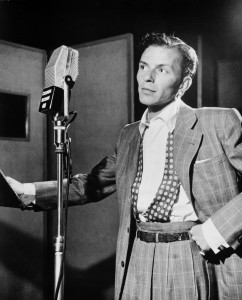On the centenary of Frank Sinatra’s birth, Paul F Cockburn looks back to his two trips to Scotland.
“The lean and hungry look came to the Glasgow Empire last night. But there was nothing lean or hungry about the audience or about the performance by Frank Sinatra,” according to the Daily Record on 7 July 1953. Under the title “‘Swoonatra’ can still knock ‘em cold,” the review went on: “The bobbysoxers may have shifted their allegiance in recent years, but I prefer Sinatra. And an audience of all ages last night obviously agreed with me.”
Yet Francis Albert Sinatra’s brief tour of Scotland that month – a Monday-to-Friday run at the Glasgow Empire (6-11 July), followed by two shows at Green’s Playhouse in Ayr (on Saturday 12 July), and a further two that Sunday (13 July) in Dundee’s cavernous Caird Hall – have since been overshadowed by tales of poor ticket sales and Sinatra’s apparent petulance about his then-“stalling” career, given that Rock ’n’ Roll and Elvis Presley were just around the corner.
Indeed, when the agent who booked those Ayr and Dundee gigs, Peter deRance, died nearly 60 years later, most media attention focused on how this otherwise highly successful agent – the man who’d brought the likes of Ken Dodd and Bob Monkhouse to Scotland – had somehow managed to lose money on “Ol’ Blue Eyes”.
Newspaper coverage from the time, however, gives no suggestion that things were not going well for Sinatra; there’s not even any mention of apparent coin-throwing by those traditionally “difficult” Glaswegian audiences. As for further north: “What a wonderfully enthusiastic crowd they were,” he said of his final Dundee audience, to a reporter from the Courier and Advertiser (now Dundee Courier).
Publicly, Sinatra expressed no disappointment over the fact that his early evening audience had consisted of around 500 people, sat in the cheaper seats towards the back of the hall. Famously, he’d invited them down to largely empty 15/- seats at the front, where he could see them: “Hey, you guys back there in Perth, move down to the front.” And they did!
Sinatra insisted that the shows weren’t simply about numbers, even when the main evening show barely filled more than half of the Caird Hall’s 2,000 seats. “That happens in other cities,” he said. “What really matters is their response, and it was wonderful. I have a very high opinion of Scottish audiences.”
Yet it would be almost 38 years before Sinatra returned, for a one-off concert at Ibrox stadium as part of Glasgow’s Year of Culture celebrations in 1990. Understandably, this long gap has fuelled speculation that, following his experiences in 1953, “the Chairman of the Board” had been in no hurry to come back to Scotland; that, in fact, his only fond memories of the entire trip had been seeing legendary American golfer Ben Hogan complete golf’s Triple Crown by winning the 1953 British Open at Carnoustie.
And, for a time, history looked as if it was going to repeat itself in 1990, when lower-than-expected ticket sales forced a scaling back of the venue’s capacity from 33,000 to 11,000 seats. Yet Sinatra – who immediately won over the crowd by introducing himself as “the American Andy Stewart” – later described Ibrox as one of the highlights of his career.
Not only did he leave the stage to stroll up and down the running track around the pitch, to be closer to the audience, “Ol’ Blue Eyes” even gave an encore – something he never usually did!
“He walked onstage, did the show, then left,” Barry Wright of Edinburgh-based Regular Music later said. “But it was obvious he was enjoying himself.”
As indeed, was his audience!
First published in Scottish Memories, December 2015.
